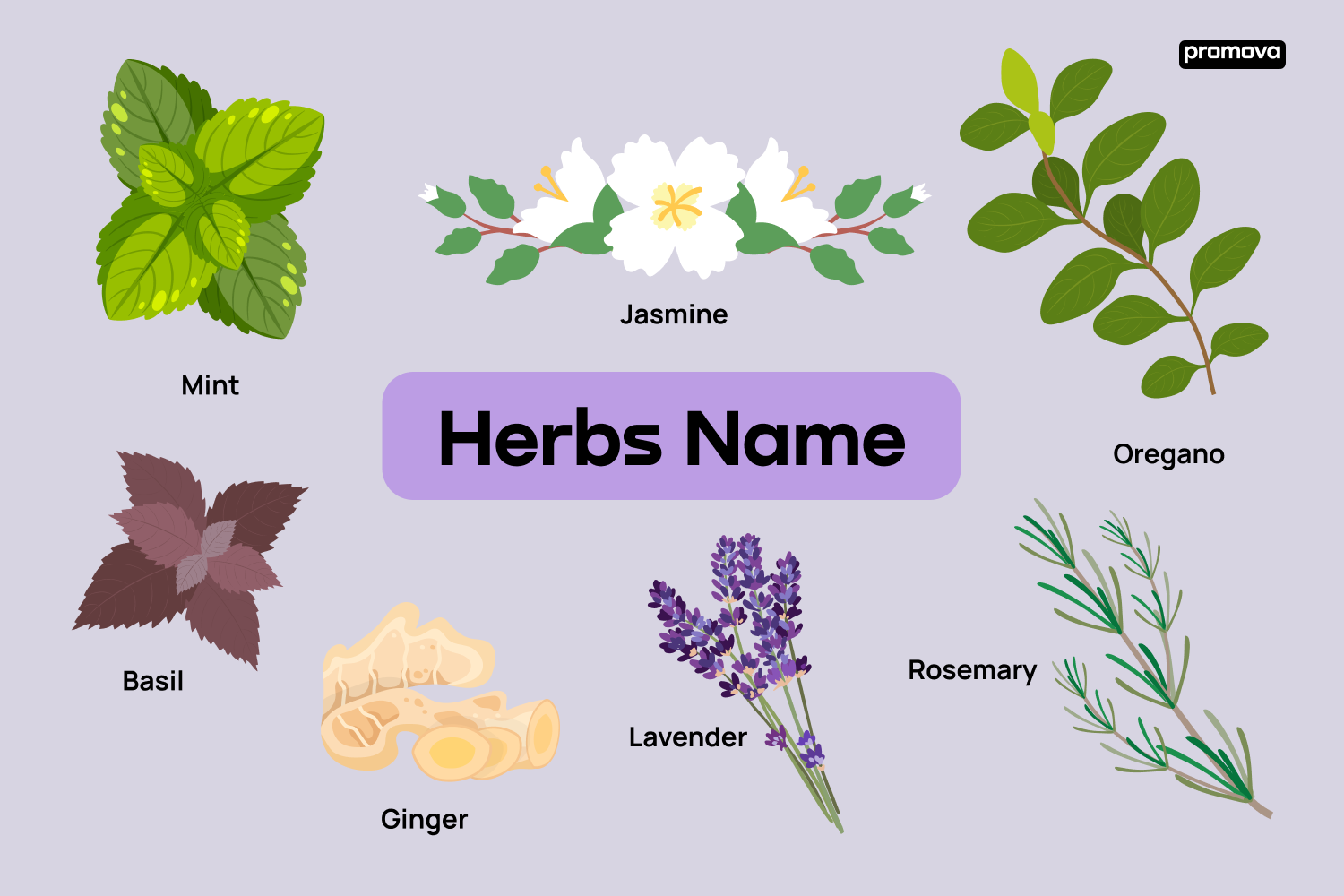Herbs Names in English
Contents
For language learners, understanding the names of common herbs can be both interesting and practical. Whether you're reading a recipe or exploring a local market, knowing these names can be incredibly handy.

Culinary Herbs
When you cook or read recipes, it's important to understand the names of various herbs. Culinary herbs are used to enhance the flavor and aroma of dishes. Below is a list of common names of herbs for culinary and their brief descriptions.
- Basil: a fragrant herb with green leaves, often used in Italian cuisine, especially with tomatoes.
- Rosemary: an evergreen shrub with needle-like leaves; has a strong flavor and is often used with meats.
- Thyme: a small-leaved herb; imparts a subtle earthy flavor, often used in stews and roasts.
- Oregano: a robust herb with pungent leaves; commonly used in Mediterranean dishes.
- Mint: a herb with aromatic leaves; commonly used in teas, desserts, and certain savory dishes.
- Parsley: a versatile herb with flat or curly leaves; often used as a garnish.
- Cilantro: a herb with flat leaves; crucial in many Asian and Latin American dishes.
- Dill: feather-like leaves; commonly used with fish and in pickles.
- Sage: Greyish-green leaves; commonly used in sausages and stuffing.
- Tarragon: an aromatic herb with narrow leaves; frequently used in French cuisine.
Recognizing these herbs will make you more confident in the kitchen. Whether you're preparing a dish or ordering at a restaurant, you'll be able to identify and describe these flavorful ingredients.
Medicinal Herbs
Apart from culinary purposes, many herbs are known for their medicinal properties. While you might not use these directly in cooking, it's useful to be familiar with their names and uses, especially if you're interested in natural remedies.
- Echinacea: a flower-like herb; believed to boost the immune system.
- Ginseng: a root herb; often used to increase energy and reduce stress.
- Lavender: a fragrant herb with purple flowers; known for its calming properties, often used in teas or essential oils.
- Chamomile: a daisy-like herb; frequently used in teas for its soothing effects.
- Turmeric: a yellow root; often used for its anti-inflammatory properties.
- Ginger: a spicy root; known for aiding digestion and reducing nausea.
- Peppermint: a strong aromatic herb; used for soothing digestive issues.
- Elderberry: a berry-producing plant; believed to help in boosting immunity.
Understanding the names of herbs and their usefulness allows you to engage in conversations about natural health remedies. If you ever explore holistic health, you'll now have a foundation to build upon.
11
Aromatic and Essential Herbs
In the realm of aromatherapy and natural fragrances, several herbs are recognized for their distinctive scents. These herbs are often distilled into essential oils or used in potpourri for therapeutic or aromatic purposes. For those of you delving into the world of natural scents and well-being, this list will be invaluable.
- Lemon Balm: a lemon-scented herb; known for its calming properties, often used in teas or essential oils.
- Eucalyptus: recognized for its strong menthol-like scent; commonly used for respiratory relief.
- Patchouli: a strong, earthy-scented herb; popular in perfumes and incense.
- Bergamot: a citrusy herb; its oil is often found in Earl Grey tea and various perfumes.
- Ylang Ylang: a flower known for its sweet, floral scent; commonly used in perfumes and aromatherapy.
- Tea Tree: recognized for its medicinal scent; often used for its antiseptic properties in skincare.
- Frankincense: a resin from the Boswellia tree; known for its calming and grounding effects in aromatherapy.
- Myrrh: a resin with a slightly sweet, smoky scent; historically used in incense and perfumes.
- Cedarwood: derived from cedar trees; its woodsy scent is calming and often used in men's fragrances.
- Sandalwood: a fragrant wood; its sweet, woody aroma is popular in perfumes and incense.
- Jasmine: a fragrant flower; its sweet, romantic scent is often used in teas and perfumes.
- Geranium: a floral-scented herb; its oil is used for balancing emotions and in skincare.
The world of aromatic herbs opens up a universe of natural scents and therapeutic benefits. By understanding and recognizing these types of herbs, you are better equipped to choose and appreciate natural fragrances and therapies.
Exotic and Less Common Herbs
Diving deeper into the world of herbs, there are several lesser-known varieties that might intrigue you. While not as mainstream, these exotic herbs offer unique flavors and properties that can be a delightful discovery.
- Lemongrass: a tall grass with a citrusy flavor; often used in Thai cuisine.
- Kaffir Lime Leaves: glossy green leaves; imparts a unique tangy flavor, used predominantly in Southeast Asian dishes.
- Fenugreek: small yellowish seeds or leaves; used in Indian cooking for its bitter taste.
- Sorrel: a leafy herb; has a sour taste and is often used in soups and sauces.
- Lovage: a tall perennial plant; tastes somewhat like celery, used sparingly in dishes.
- Rue: a strong herb with a bitter taste; used in traditional medicines and some Mediterranean dishes.
- Epazote: a pungent herb; essential in many traditional Mexican dishes.
- Borage: a herb with star-shaped flowers; the leaves have a cucumber-like taste.
- Chervil: a delicate herb; often used to flavor soups and salads in French cuisine.
- Marjoram: a sweet aromatic herb; similar to oregano but milder.
While these herbs might not be as commonly recognized, expanding your knowledge of them can make you a more adventurous cook or traveler.
Conclusion
Herbs play a crucial role in both our kitchens and our lives. For language learners like you, understanding the names of herbs is a small but significant step in becoming more proficient in English. Now that you're familiar with these herbs, you can confidently discuss, use, and enjoy them in various contexts.



Comments